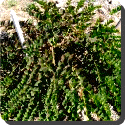 Caper — The caper (Capparis spinosa L.) is a perennial spiny shrub that bears rounded, fleshy leaves and big white to pinkish-white flowers. A caper is also the pickled bud of this plant. The bush is native to the Mediterranean region, growing wild on walls or in rocky coastal areas throughout. The plant is best known for the edible bud and fruit (caper berry) which are usually consumed pickled. Other species of Capparis are also picked along with C. spinosa for their buds or fruits.
Caper — The caper (Capparis spinosa L.) is a perennial spiny shrub that bears rounded, fleshy leaves and big white to pinkish-white flowers. A caper is also the pickled bud of this plant. The bush is native to the Mediterranean region, growing wild on walls or in rocky coastal areas throughout. The plant is best known for the edible bud and fruit (caper berry) which are usually consumed pickled. Other species of Capparis are also picked along with C. spinosa for their buds or fruits.
Capparis spinosa is highly variable in nature in its native habitats and is found growing near the closely related species C. sicula, C. orientalis, and C. aegyptia. Scientists can use the known distributions of each species to identify the origin of commercially prepared capers.
The shrubby plant is many-branched, with alternate leaves, thick and shiny, round to ovate in shape. The flowers are complete, sweetly fragrant, showy, with four sepals, and four white to pinkish-white petals, many long violet-colored stamens, and a single stigma usually rising well above the stamens.
Capers can be grown easily from fresh seed, gathered from ripe fruit and planted into well drained seed-raisng mix. Seedlings will appear in 2-4 weeks. Old, stored seed enters a state of dormancy and requires cold stratification in order to germinate. Cuttings from semi-hardwood shoots taken in Autumn may root, but this is not a reliable means of propagation.Caper plants prefer full sun in hot/warm temperate climates and should be treated much like cacti. They require regular watering in summer and very little during winter and are deciduous, though in warmer climates they may simply stop growing. Capers have a curious reaction to sudden increases in humidity- they form wart-like pock marks across the leaf surface. This appears to be harmless as the plant quickly adjust to the new conditions and produce unaffected leaves.
Seedling capers can be expected to flower from the second to third year and live for at least decades, and probably much longer.
 Kids Portal For Parents India Kids Network
Kids Portal For Parents India Kids Network






